Occupational environment monitoring at a construction site
99,000 ₫
Note: The above price is calculated for one sample, and the price may fluctuate depending on the area of the environment to be monitored and market movements. For more accurate pricing support, please refer to the price list or contact our consulting staff directly.
Monitoring the environment of a construction site is a session of collecting, analyzing, and evaluating factors at the workplace that may harm workers health.
Table of Contents
Toggle1. Overview of Construction Sites
a. What is a Construction Site?
Construction Site is a place where construction, installation, or repair of civil, industrial, or infrastructure works is carried out. It is a temporary workspace established to perform construction tasks from preparation to completion.

b. Jobs at Construction Sites
Construction sites have various jobs, each with specific roles and responsibilities. Below are some common jobs at construction sites:
- Construction Engineers: Construction engineers manage and supervise construction works. They plan, design, and oversee construction activities to ensure completion on schedule, with quality and budget adherence.
- Construction Workers: Construction workers perform physical tasks on-site, including excavation, wall building, structural assembly, electrical and plumbing installation, and interior finishing.
- Carpenters and Ironworkers: Carpenters and ironworkers are responsible for cutting, bending, welding, and installing wooden and metal structures on the construction site.
- Electricians and Electromechanical Technicians: They install, inspect, and maintain electrical, HVAC, ventilation, and other electromechanical systems at construction sites.
- Plumbers and Infrastructure Technicians: They install, inspect, and maintain water, drainage, and other infrastructure systems at construction sites.
- Finishers: Finishers perform final tasks to complete the construction works, including painting, tiling, installing doors, windows, floors, ceilings, and interior decoration.
- Specialized Workers: Special tasks such as concrete finishing, waterproof painting, and coating are performed by specialized workers at construction sites.

c. Machinery Used at Construction Sites
Construction sites use various machinery to perform construction tasks efficiently and quickly. Some common machinery includes:
- Excavator: Used for digging and moving soil, rocks, and construction materials. Excavators have a boom and are equipped with tracks or wheels.
- Bulldozer: Used for pushing soil and leveling surfaces. Equipped with a front blade and either tracks or wheels.
- Crane: Used to lift and move heavy materials such as steel, concrete, and construction components. Includes tower cranes, mobile cranes, and gantry cranes.
- Concrete Mixer: Used to mix and produce concrete. Mixers can be drum mixers or self-loading concrete mixers.
- Compactor: Used to compress and compact soil. Types include plate compactors, tracked compactors, and roller compactors.
- Loader: Used to lift and move construction materials such as soil, sand, rocks, and concrete. Loaders may have tracks or wheels.
- Drilling Machine: Used to drill holes in soil, rock, and concrete. Types include handheld drills, rotary drills, or vertical drilling machines.
- Tractor: Used to pull and move construction equipment and materials, usually equipped with tracks or wheels.

d. Occupational Diseases for Construction Workers
Workers at construction sites may suffer from certain occupational diseases due to exposure to harmful factors in the construction environment. Some common occupational diseases include:
- Respiratory Diseases: Workers may suffer from pneumonia, sinusitis, asthma, or lung diseases due to exposure to dust, metal fumes, chemicals, and other pollutants during construction.
- Infectious Diseases: Contact with dirty environments, groundwater, or waste can lead to infections caused by bacteria such as Leptospira, Bacillus anthracis, or mold-related pathogens.
- Skin Diseases: Construction work may cause skin irritation, dermatitis, allergic dermatitis, and other skin issues due to chemical exposure, dust, or mechanical impacts such as cuts or punctures.
- Accident-related Injuries: Construction sites carry high risks of workplace accidents including falls, being struck by heavy objects, cuts, electrocution, and other injuries.
- Musculoskeletal Disorders: Heavy physical work, lifting, and awkward positions can cause spine, joint, and musculoskeletal problems such as spinal degeneration, arthritis, back pain, and joint deterioration.
It is important to follow safety regulations and use personal protective equipment to protect the health of workers at construction sites.

e. Products Used in Construction Sites
Construction sites manufacture and use various products for constructing buildings and infrastructure. Some common products include:
- Construction Materials: Including cement, sand, stone, bricks, wood, steel, glass, and other building materials used for walls, foundations, floors, ceilings, and other structures.
- Concrete: A key product in construction used for columns, floors, foundations, and other structures, typically made from cement, sand, stone, and water.
- Steel Structures: Steel bars and plates used to construct structural frames and supports in buildings, bridges, and factories.
- Insulation and Soundproofing Materials: Materials used for thermal and acoustic insulation, such as fiberglass, mineral wool, and insulation boards.
- Electrical Insulation Materials: Used in electrical systems and equipment, including wires, insulating pipes, boards, and other insulating materials.
- Water Supply and Drainage Systems: Pipes, tanks, pumps, drainage systems, and related equipment for water supply and drainage.
- Electrical Systems: Includes cables, junction boxes, switches, outlets, and other electrical equipment for powering construction sites.
- Doors and Windows: Wood, steel, aluminum, and glass doors and windows for entry, ventilation, and lighting in construction projects.

2. Overview of Occupational Environment Monitoring Services
a. What is Occupational Environment Monitoring at Construction Sites?
Occupational environment monitoring (or workplace environmental measurement) at construction sites is the activity of collecting, evaluating, and analyzing indicators of workplace environmental factors. This allows timely mitigation measures, reducing environmental hazards to workers’ health, and preventing occupational diseases. Occupational environment monitoring is mandatory for all construction sites.
Occupational environment monitoring plays a crucial role in caring for, protecting, and enhancing workers’ health because the main resource of any business—and the one that directly generates profit—is its workforce. Workers regularly exposed to risk factors beyond permissible limits may suffer health impacts and occupational diseases.
REGISTER FOR OCCUPATIONAL ENVIRONMENT MONITORING SERVICE
b. An Toan Nam Viet’s Occupational Environment Monitoring Program
An Toan Nam Viet’s occupational environment monitoring program is developed by engineers specialized in workplace safety and environmental protection. Aiming to ensure workers’ health and safety, the program employs modern measurement methods to monitor air quality, water, microclimate, physical factors, and dust in the workplace. This program is vital to maintaining a safe working environment and protecting workers’ health.
Additionally, An Toan Nam Viet’s program plays an important role in researching and developing solutions to improve workplace environmental quality. With the dedication and professionalism of its monitoring experts, An Toan Nam Viet’s exclusive monitoring program represents a breakthrough in occupational safety and environmental management in Vietnam.

c. Standardization in Workplace Measurement Procedures
Standardization in workplace measurement procedures at An Toan Nam Viet is essential for ensuring measurement accuracy. To guarantee reliable results, the program applies recognized standards and procedures from the Ho Chi Minh City Department of Health. This ensures that collected data can be used reliably to assess workplaces and make decisions to improve working conditions and protect workers’ health.
Standardized procedures also ensure that measurements are conducted by highly qualified monitoring specialists, giving managers and experts confidence in An Toan Nam Viet’s results for accurate, valuable decisions in safeguarding worker health and the environment.
By applying standardized procedures, An Toan Nam Viet demonstrates its commitment to ensuring a safe working environment and protecting workers’ health, while positively contributing to occupational safety and environmental management in Vietnam.
d. Reporting Construction Site Monitoring Results
Occupational environment monitoring results are prepared according to Form No. 04, Appendix III issued with Decree 44/2016/ND-CP and prepared in two copies: one sent to the contracting workplace and one retained by the monitoring organization.
The retention period for monitoring results follows legal regulations and is indefinite.

e. Frequency of Workplace Monitoring According to Law
According to Clause 2, Article 18 of the Labor Safety and Hygiene Law 84/2015/QH13, employers must conduct workplace environmental monitoring of harmful factors at least once a year.
f. Deadline for Submitting Workplace Monitoring Reports According to Law
The deadline is before December 31 each year. Enterprises must submit workplace monitoring reports to the local Department of Health at the location of their main office and where workers are employed.
Whenever there are changes in technology, manufacturing processes, or when upgrading facilities that may introduce new harmful factors, enterprises must update occupational hygiene records related to factors requiring workplace monitoring.
g. Penalties for Violations in Workplace Environmental Monitoring by Employers
According to Article 27 of Decree No. 12/2022/ND-CP dated January 17, 2022:
- Clause 2: Fines from VND 2,000,000 – 5,000,000 for employers who fail to publicly disclose monitoring results to employees at the monitoring site immediately after results are available.
- Clause 3: Fines from VND 20,000,000 – 40,000,000 for employers who do not conduct workplace monitoring as required by law.
- Clause 4: Fines from VND 40,000,000 – 60,000,000 for employers who collude with monitoring organizations to commit fraud in workplace monitoring activities without reaching criminal liability.
3. Harmful Environmental Factors for Workers at Construction Sites
Workers at construction sites face various harmful environmental factors that may affect their health. Here are some potential harmful factors at construction sites:
- Dust: Construction work often generates dust from building materials such as cement, sand, stone, and wood. Inhaling dust can irritate the respiratory tract, cause pneumonia, rhinitis, and other respiratory problems.
- Chemicals: Construction sites use many chemicals such as dyes, adhesives, waterproofing agents, fire retardants, and solvents. Exposure to these chemicals can cause skin irritation, dermatitis, and bleeding risks.
- Noise: Construction sites are exposed to noise from machinery, tools, and construction activities. Prolonged high noise can damage hearing and cause auditory problems.
- Vibrations: Working with heavy machinery such as excavators, compactors, and drills can cause vibrations. Long-term exposure may result in musculoskeletal injuries, spinal issues, and muscle fatigue.
- Temperature and humidity: Construction environments can have high or low temperatures, high humidity, or dry conditions. Exposure to non-ideal conditions can cause colds, fever, heat stress, and heatstroke.
- Height: Working on high-rise construction sites or elevated structures can be dangerous and cause safety concerns. The risk of falling from heights can lead to serious accidents or even death.
REGISTER FOR OCCUPATIONAL ENVIRONMENT MONITORING SERVICE
4. Measures to Improve Working Conditions at Construction Sites
Improving working conditions at construction sites is essential to protect workers’ health and safety. The following measures can be applied:
- Ensure compliance with safety regulations: Adhering to safety rules and procedures is crucial to minimize risks and accidents at construction sites. Ensure all workers are trained in safety and use personal protective equipment (PPE).
- Provide personal protective equipment (PPE): Ensure all workers are supplied with appropriate PPE such as helmets, goggles, masks, gloves, and safety shoes. PPE protects against harmful factors like dust, chemicals, noise, and vibrations.
- Control dust and pollutants: Use dust control measures such as vacuum systems, suction pipes, and designated zones to prevent dust and pollutants from spreading. Ensure proper airflow and ventilation.
- Reduce noise: Apply noise reduction measures, including using noise-proof equipment, isolating noise sources, and regularly inspecting and maintaining machinery to reduce noise at the source.
- Chemical management: Ensure chemicals are stored, used, and disposed of properly. Follow safety instructions and use PPE when handling chemicals.
- Ensure comfortable temperature and humidity: Provide a comfortable working environment regarding temperature and humidity.
- Periodically conduct occupational environment monitoring at the factory, collect and analyze harmful factors affecting workers, then implement adjustments to reduce risks and prevent occupational diseases for them.
5. Benefits of Regular Monitoring at Construction Sites
An Toan Nam Viet provides businesses with excellent benefits when using occupational environment monitoring services in accordance with Decree 44/2016/ND-CP on managing and controlling harmful factors in the workplace affecting workers.
- Businesses can proactively control harmful factors at workshops or factories.
- Receive advice and recommendations on measures to reduce harmful factors and improve workplace environment quality.
- Indirectly protect human resources, a key factor in business development.
- Reduce the impact of occupational diseases on workers’ health, lowering future treatment costs.
- Improve workers’ health, leading to better product quality and consistent output.
- Comply with labor safety regulations and avoid legal risks.
- Enhance reputation and professionalism, elevating the business’s brand.
Nam Viet’s occupational environment monitoring service is a solution to reduce occupational disease risks, contributing to a healthy and high-quality working environment.

6. National Occupational Environment Monitoring Center
Nam Viet Occupational Environment Monitoring Center is a professional unit specializing in supervising and measuring workplace environmental quality throughout all provinces in Vietnam. With an experienced team of monitoring specialists, the center uses modern measurement devices to ensure accuracy and reliability.
In addition to monitoring services, the center assists clients in planning, handling, and tracking workplace environmental issues. Following the motto “customer-centered,” the center prioritizes client satisfaction, meets all needs, and provides the best solutions for businesses.
REGISTER FOR OCCUPATIONAL ENVIRONMENT MONITORING SERVICE
With investments in technology, equipment, and workforce, Nam Viet’s monitoring center has become one of the most reputable units in occupational environment monitoring in Ho Chi Minh City with the following goals:
- We always value brand reputation and the quality of our services.
- We provide clients with the best and most suitable solutions possible.
- Alongside a team of experienced Masters and Engineers, we aim to protect the environment and benefit businesses.
- Working with Nam Viet Environmental Monitoring, companies receive professional service from experts and the best cost advantages.
The occupational environment monitoring process at Nam Viet includes the following basic steps:
- Before monitoring, all equipment is calibrated and compliant with legal regulations.
- Carry out the monitoring process fully and correctly as committed to the Department of Health.
- Accurately report monitoring results to employers.
- If results indicate unsafe conditions, Nam Viet provides corrective solutions, and the facility implements the following:
- Implement measures to improve working conditions, minimizing harmful factors and preventing occupational diseases.
- Organize health checkups to detect occupational and work-related diseases early for employees in unsafe positions.
- Provide material support to employees according to labor law regulations.

7. Pricing for Occupational Environment Monitoring
To help businesses carry out occupational environment monitoring professionally and effectively, Nam Viet provides clients with a detailed and reasonable price list for monitoring services.
- The price list provides detailed information about the costs of monitoring services, including transportation, measurement, analysis, and reporting. Clients can trust the accuracy and reliability of the reports.
- We always offer competitive and reasonable prices and are ready to answer all inquiries quickly and professionally.
- With Nam Viet’s price list, clients can easily select service packages that suit their needs. We commit to delivering maximum satisfaction with professional service quality.
1 review for Occupational environment monitoring at a construction site
No comments yet

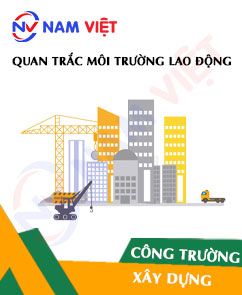
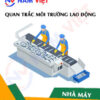
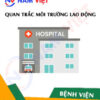




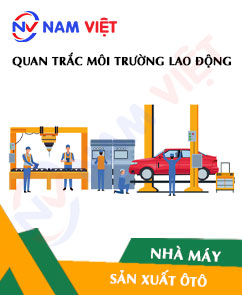

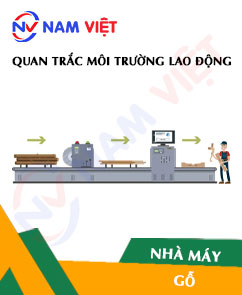

maituyet.cuong12
Good labor environment monitoring service!